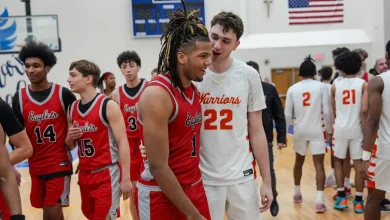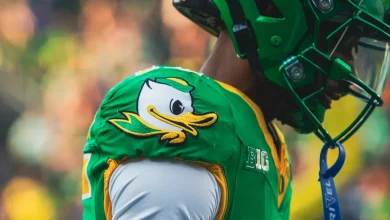Daniel Jones is just the latest installment of the NFL’s second-act QB trend

Daniel Jones’ shocking production this season could be another sign of the NFL’s newest QB trend.
As a first-round draft pick who was cast aside by his original team, Jones went into last offseason with no direct path to claiming another starting job. The New York Giants released him midway through 2024, and he spent the remainder of the season on the Minnesota Vikings’ practice squad before joining the Indianapolis Colts on a one-year, $14 million deal to compete with Anthony Richardson.
Of course, Jones’ MVP-caliber performance to date — a 71.2 completion percentage, 2,062 yards, 13 touchdowns, three interceptions, four rushing scores and a league-best 7-1 record for Indianapolis — has validated the Colts’ decision to unseat Richardson. And big picture, Jones joins Baker Mayfield, Sam Darnold, Geno Smith and Mac Jones as quarterbacks who have endured similar journeys and thrived on the other side, rewriting their own narratives. And because so much of their bounce-back successes occurred on budget-friendly contracts, the QBs have also represented extraordinary value to their teams.
“If you aren’t in position to draft and develop a guy,” a team executive said, “it makes a lot of sense to try one of these bridge options if you feel confident enough in your system and the roster. Then you can build up the team around him to support your quarterback.”
The similarities are obvious. Daniel Jones, Mayfield, Darnold and Mac Jones were high- or mid-first-rounders, while Smith was an early second-rounder. League executives agreed each player has always possessed the physical skills to start in the NFL, which was indicative of their draft stock.
But examine where they wound up. The Cleveland Browns selected Mayfield with the No. 1 pick in 2018, as he joined an organization that went a combined 1-31 over its previous two seasons. And considering the Browns’ extensive history of cycling through quarterbacks, Mayfield already had long odds to live up to the hype.
The New York Jets took Darnold at No. 3 in the same draft. The team subsequently fired two head coaches in Darnold’s first three seasons before trading him to the Carolina Panthers. The Jets, who haven’t been to the playoffs in 15 years, have inspired little confidence in their organizational plan to develop a QB. Much of the same can be said for Smith’s tour, which began in 2013.
The New England Patriots selected Mac Jones with the 15th pick in 2021, and the pairing worked well for much of his encouraging rookie season, but things devolved in 2022. Bill Belichick’s stunning mishandling of Jones was a major reason the Patriots had little choice but to fire the future Hall of Fame coach.
Daniel Jones had his own hurdles with the New York Giants, who selected him No. 6 in 2019. They also fired two head coaches in his first three seasons, but Brian Daboll’s arrival in 2022 led to Jones’s best season to date. The Giants rewarded Jones with a four-year, $160 million extension, but they couldn’t give him enough support while managing a chaotic salary cap situation in the wake of general manager Dave Gettleman’s firing. Jones’ play bottomed out without enough help around him.
“We do more as teams to screw up these guys than anything (the quarterbacks) do,” another executive said.
Of course, these second acts are no sure thing. Mayfield and Darnold each failed during their second stops, with the Carolina Panthers. Justin Fields, a 2021 first-rounder, struck out with the Chicago Bears and Pittsburgh Steelers, and it’s not looking promising with the Jets. Another 2021 first-round pick, Zach Wilson, another lost cause with the Jets, has since navigated the backup circuit with the Denver Broncos and Miami Dolphins.
Smith is another interesting example. Count him among the young QBs who had a forgettable run with the Jets before he moonlit as a backup with the Giants, Los Angeles Chargers and Seattle Seahawks. But after Seattle pivoted from Russell Wilson to Smith, the veteran ripped off the three most impressive seasons of his career — starting at age 32, eight years after his last stint as a full-time starter. For the most part, the Seahawks were equipped to complement their QB across the board, and the results followed.
But after a snag in offseason contract negotiations, Smith orchestrated a trade to the Las Vegas Raiders to reunite with coach Pete Carroll. The problem, of course, is the Raiders are in the early stages of a rebuild, and Smith’s performance has suffered. Support matters.
Darnold took a gap year in 2023 with San Francisco 49ers head coach Kyle Shanahan before refining his tools in 2024 with Minnesota Vikings coach Kevin O’Connell. Even still, Darnold may have never seen the field if it weren’t for then-rookie J.J. McCarthy’s meniscus surgery. Darnold had a career season and turned it into a three-year, $100.5 million contract with the Seahawks.
Mayfield rebuilt his confidence with the Los Angeles Rams in 2022 before joining the Tampa Bay Buccaneers in 2023, for one year and $4 million. He cruised past Kyle Trask in a camp competition, led the Bucs to the playoffs and cashed in for three years and $100 million. Mayfield is expected to resume negotiations for a raise in the offseason, likely increasing his average annual value into the range of $40 million to $50 million.
Daniel Jones seems to be on a similar course. His brief stop with O’Connell in Minnesota provided a low-stress respite and a crash course in one of the league’s most QB-friendly systems before he assessed his offseason options.
Up to that point, the Colts couldn’t have been viewed as favorably as some of the other soft landing spots. They failed the bridge route with Philip Rivers, Matt Ryan and Carson Wentz, and Richardson’s career has been sabotaged by injuries. Head coach Shane Steichen, who was credited for his work with Jalen Hurts as the Philadelphia Eagles’ offensive coordinator, still appeared to be a mystery as a head coach. But Steichen’s chemistry with Jones has yielded the league’s best offense through eight weeks. The offensive line is in a better place, and running back Jonathan Taylor has been his QB’s best friend. It’s not like Jones was a slam dunk, either — if that were the case, he wouldn’t have gotten paid like a No. 3 wide receiver. But if this continues, Jones will join Mayfield and Darnold in a significantly higher tax bracket.
It could eventually happen for Mac Jones, too, though he’s under contract through 2026. He may be a trade chip, but the 49ers may not want to gamble with starter Brock Purdy’s injury history. In the not-so-distant future, teams may have an opportunity to show Jones how they truly view him.
“We knew these guys were physically gifted players who could run NFL offenses when they were coming out of the draft,” the second executive said. “They just needed to go to the right situations to be successful.”
Make no mistake, this isn’t the ideal way to target a quarterback, as teams would much rather get one in the draft. But it’s paramount for those organizations to have a functional plan in place for young, impressionable QBs. They need the coaching, the behind-the-scenes processes and patience from ownership, not to mention a competent offensive line and capable weapons. It’s rarely the case that all these criteria are met by a team picking in the top five of the draft.
It’s also vital to not be blinded by the conservative approach of building the roster before inserting the QB. If you recall, there was an argument the Patriots should have drafted an offensive tackle or a wide receiver in 2024 over Drake Maye. How ridiculous would that plan look now on the heels of Maye’s second-year-surge?
Really, it has more to do with the teams in the middle class, those that perennially draft a bit too late for a blue-chip prospect. The Browns (Deshaun Watson), Broncos (Russell Wilson) and Jets (Aaron Rodgers) recently failed spectacularly while trying to acquire a ready-made QB with a proven track record of being one of the best at his position, setting their franchises back by years with poor investments. And while there’s no guarantee these revival projects will all continue to work, the value is twofold when they do. The price tag for a homegrown QB these days is roughly $55 million per year, and there’s been no correlation to paying that premium and experiencing team success.
When someone like Mayfield pans out and even earns a raise, the Buccaneers still have a ton more to spend than NFC rivals like the Dallas Cowboys, Philadelphia Eagles and San Francisco 49ers. It’s no coincidence the Bucs have managed their injuries better than those other teams, because the middle class of their roster is better fortified.
It’s fair to call this strategy a cheat code because of the advantages it presents. But it’s anything but an automatic solution. The teams that have done it the best can point to an extensive process that’s conducive to a QB’s revival.





